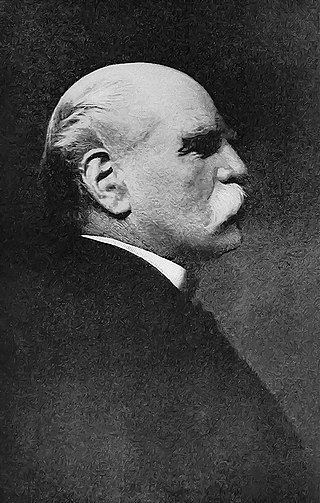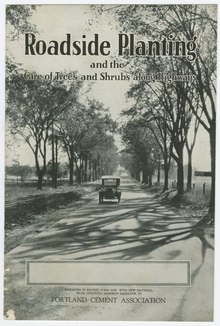
Concrete is a composite material composed of fine and coarse aggregate bonded together with a fluid cement that hardens (cures) over time. Concrete is the second-most-used substance in the world after water, and is the most widely used building material. Its usage worldwide, ton for ton, is twice that of steel, wood, plastics, and aluminum combined. Globally, the ready-mix concrete industry, the largest segment of the concrete market, is projected to exceed $600 billion in revenue by 2025. This widespread use results in a number of environmental impacts. Most notably, the production process for cement produces large volumes of greenhouse gas emissions, leading to net 8% of global emissions. Other environmental concerns include widespread illegal sand mining, impacts on the surrounding environment such as increased surface runoff or urban heat island effect, and potential public health implications from toxic ingredients. Significant research and development is being done to try to reduce the emissions or make concrete a source of carbon sequestration, and increase recycled and secondary raw materials content into the mix to achieve a circular economy. Concrete is expected to be a key material for structures resilient to climate disasters, as well as a solution to mitigate the pollution of other industries, capturing wastes such as coal fly ash or bauxite tailings and residue.

A cement is a binder, a chemical substance used for construction that sets, hardens, and adheres to other materials to bind them together. Cement is seldom used on its own, but rather to bind sand and gravel (aggregate) together. Cement mixed with fine aggregate produces mortar for masonry, or with sand and gravel, produces concrete. Concrete is the most widely used material in existence and is behind only water as the planet's most-consumed resource.

Portland cement is the most common type of cement in general use around the world as a basic ingredient of concrete, mortar, stucco, and non-specialty grout. It was developed from other types of hydraulic lime in England in the early 19th century by Joseph Aspdin, and is usually made from limestone. It is a fine powder, produced by heating limestone and clay minerals in a kiln to form clinker, grinding the clinker, and adding 2 to 3 percent of gypsum. Several types of portland cement are available. The most common, called ordinary portland cement (OPC), is grey, but white Portland cement is also available. Its name is derived from its resemblance to Portland stone which was quarried on the Isle of Portland in Dorset, England. It was named by Joseph Aspdin who obtained a patent for it in 1824. His son William Aspdin is regarded as the inventor of "modern" portland cement due to his developments in the 1840s.

Reinforced concrete (RC), also called reinforced cement concrete (RCC) and ferroconcrete, is a composite material in which concrete's relatively low tensile strength and ductility are compensated for by the inclusion of reinforcement having higher tensile strength or ductility. The reinforcement is usually, though not necessarily, steel bars (rebar) and is usually embedded passively in the concrete before the concrete sets. However, post-tensioning is also employed as a technique to reinforce the concrete. In terms of volume used annually, it is one of the most common engineering materials. In corrosion engineering terms, when designed correctly, the alkalinity of the concrete protects the steel rebar from corrosion.

Ready-mix concrete (RMC) is concrete that is manufactured in a batch plant, according to each specific job requirement, then delivered to the job site "ready to use".

The Mystic Order of Veiled Prophets of the Enchanted Realm, also known as M.O.V.P.E.R. or The Grotto, after its lodge equivalent, is an appendant body in Freemasonry.

Cast stone or reconstructed stone is a highly refined building material, a form of precast concrete used as masonry intended to simulate natural-cut stone. It is used for architectural features: trim, or ornament; facing buildings or other structures; statuary; and for garden ornaments. Cast stone can be made from white and/or grey cements, manufactured or natural sands, crushed stone or natural gravels, and colored with mineral coloring pigments. Cast stone may replace such common natural building stones as limestone, brownstone, sandstone, bluestone, granite, slate, coral, and travertine.
Polymer concrete, also known as Epoxy Granite, is a type of concrete that uses a polymer to replace lime-type cements as a binder. In some cases the polymer is used in addition to Portland cement to form Polymer Cement Concrete (PCC) or Polymer Modified Concrete (PMC). Polymers in concrete have been overseen by Committee 548 of the American Concrete Institute since 1971.
The American Concrete Institute is a non-profit technical society and standards developing organization. ACI was founded in January 1905 during a convention in Indianapolis. The Institute's headquarters are currently located in Farmington Hills, Michigan, USA. ACI's mission is "ACI develops and disseminates consensus-based knowledge on concrete and its uses."

Concrete is produced in a variety of compositions, finishes and performance characteristics to meet a wide range of needs.

Geopolymer cement is a binding system that hardens at room temperature.

The Concrete Herald is a newspaper serving the town of Concrete, Washington, along with other communities in Skagit County in the United States. The newspaper has received multiple awards from the Washington Newspaper Publishers' Association, Washington State Press Club, and various other state and local organizations. The Herald's publications have initiated various public projects in the area and played a key role in fighting industrial pollution in Concrete. The publication serves as a cohesive element for the community of the Upper Skagit Valley. Published as a weekly newspaper from 1901 until its dissolution in 1991, The Concrete Herald was relaunched as a monthly publication in 2009.

The Concrete Heritage Museum is a local heritage museum in Concrete, Washington. The museum focuses on the industrial history of the region, with collections dedicated to the Superior Portland Cement Company, the Lower Baker Dam, and the region's rich history of logging. The museum maintains an archive of The Concrete Herald, a historical local newspaper established in 1901. The museum has regular summer weekend hours, but is open by appointment only otherwise.

Charles Muth Dwelley was a community activist of Skagit County and owner/editor in chief of The Concrete Herald newspaper for over 40 years, from 1929 to 1970. Many of his editorials were quoted nationwide in Reader's Digest, The New York Times, etc. and occasionally referred to among professional journalists as "Dwellisms." He served as the president of the Washington State Publishers' Association in 1957 and 1958, received multiple awards in journalism, and repeatedly represented Washington State at the National Editorial Association.
The Atlas Portland Cement Company, based in Northampton, Pennsylvania, was one of the largest cement companies of the world. Founded in Northampton in 1895, Atlas operated there until 1982 when it was bought out. It manufactured Portland cement, the most common type of cement in the world.

William Henry Mitchell was a pioneer of the Washington Territory and Olympia who made big contributions to the city's industrial and business development. He was a member of the Washington State Legislature and the Pioneer's Association of the State of Washington, an Olympian Town Trustee and a joint councilman for Thurston and Lewis counties.

Calvin Sam Barlow was a pioneer and politician of Tacoma, Washington. He was considered one of the most successful merchants of the city. In 1877, he came to Tacoma–a small village at the time–and opened its first butcher shop. Barlow successfully conducted the business for three years in partnership with his brother. Later, they founded the Tacoma Trading Company and started dealing in various building materials as well as manufacturing their own. In 1903, their company was one of the largest in the city, and one of the leading merchants. It was stated that the company supplied near three-fourths of the lime for all of the Tacoma buildings of that time. Over the years, Barlow became a highly esteemed Tacoma merchant.

Thomas Payne Westendorf was an American songwriter, composer, and educator. Westendorf wrote around 500 musical pieces and songs, but was most famous for his hit song, "I'll Take You Home Again, Kathleen." It was the only Westendorf song that lived long enough to receive rights protection renewal. It was republished many times throughout the years and sung by singers including Elvis Presley, Mitch Miller, Bing Crosby, and Johnny Cash. "I'll Take You Home Again, Kathleen" was listed among the most popular American ballads in 1887, and gained recognition as one of the most beloved songs in music history. It was included in a number of musical collections and used in motion pictures, including Mrs. Parkington and Magic Town. It even made a brief appearance on an early episode of "Star Trek".
George Crawford Britton (1854–1929) was a politician and lawyer in the states of Iowa, South Dakota, Washington, and Alaska. He represented Spink County in the Dakota Territory legislation and was a member of the Washington State Legislature and Tacoma City Council. He had a successful legal career in Iowa, South Dakota, and Washington states, and served as a judge, United States commissioner, and notary public in Alaska.
Clandulla is a village in New South Wales, Australia, within the Mid-Western Regional Council, about 225 kilometres north-west of Sydney. At the 2016 census Clandulla and the surrounding rural district had a population of 197, living in 61 private dwellings. The township and district also included 22 unoccupied private dwellings. Clandulla is bounded to the west and north by the Clandulla State Forest.
















